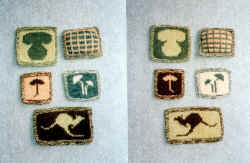| REVERSIBLE KNITTING | |
| Workshop Leader: Marilyn Caddell, (Scotland) | |
| “I thought this would be a way that delegates could use small amounts of fungi dyed yarn obtained from pot luck dye workshops, or from experiments of their own. The technique | |
| involves knitting two colours at once, one behind the other, so that the knitting is reversible i.e. green with a brown image on one side and brown with a green image on the other. In making a garment, the welts, cuffs and collar would be knitted using both colours together, giving a mottled effect, and then the two | |
|
"Samples of reversible knitting by Marilyn Caddell, Scotland" |
|
| colours
knitted separately for the main body to give a double fabric.
For the workshop I had worked out graphs - three of different mushrooms and one of a kangaroo. These were knitted up into small sample squares by the attendees. The concentration levels were amazing. Conversation came to a stop! Stitches are arranged in alternate colours along the needle (A B A B A B , etc.) Stitch A is knitted and then the yarn brought immediately to the front of the needle, stitch B is then purled. Yarn A can then be returned to the back of the needle ready to knit the next stitch A ....... and so on. Knitters will hopefully understand what I mean! If only ONE colour is used in each row, then at the top of the knitting it is possible to separate the stitches on two needles (all A's on one and all B's on another). The two sides of the knitting will then be separate and can be made into a bag or cushion. There is plenty of scope to exploit this. One attendee was very excited by this possibility to make bags and was looking forward to experimenting when she got home. Several stayed long after the workshop time ended to make sure they had got to grips with the technique.” |
|















